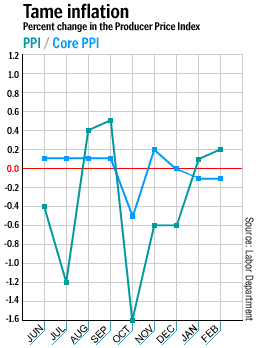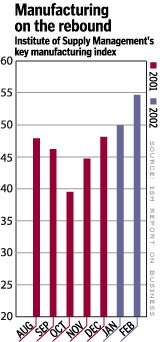
NEW YORK (CNN/Money) -
A closely watched gauge of U.S. consumer sentiment posted a surprising gain in March, according to a published report Friday, while the Federal Reserve said industrial output rose again in February, the latest signs that the U.S. economy is recovering from its first recession in a decade.
And wholesale prices posted small gains in February, according to a separate government report Friday, as inflation remained a distant threat, freeing the Fed to possibly leave short-term interest rates relatively low.
The closely watched University of Michigan consumer sentiment index rose to 95 in early March, according to a Reuters report, compared with a reading of 90.7 in February. Economists surveyed by Briefing.com expected an index reading of 93.
The current conditions index, which measures Americans' attitudes about their present financial situation, rose to 99.3 from 96.2 in February, said Reuters. The wire service cited sources who had seen the survey, which is available only to paying subscribers. The expectations index, measuring hopes for the coming year, rose to 92.3 from 87.2 in February, Reuters said.
"It clearly tells us that consumers have and will continue to sustain and support economic growth," said Sung Won Sohn, chief economist at Wells Fargo & Co. "Consumers have really been the backbone of current economic growth and will continue to be a stabilizer for the balance of this year."

Separately, the Federal Reserve said industrial production rose 0.4 percent in February after a revised 0.2 percent increase in January. Economists surveyed by Briefing.com expected industrial production to rise 0.2 percent.
The Fed, the nation's central bank, said factories used 74.8 percent of their capacity in February, above January's level of 74.5 percent. Economists surveyed by Briefing.com expected capacity utilization to come in at 74.4 percent.

And the Producer Price Index -- a measure of prices paid to factories, farmers and other producers -- rose 0.2 percent after rising 0.1 percent in January, the Labor Department said. Economists surveyed by Briefing.com expected prices to rise 0.2 percent.
Excluding often-volatile food and energy prices, the "core" PPI was unchanged after falling 0.1 percent in December. Economists surveyed by Briefing.com expected core prices to rise 0.1 percent.
"Inflation has been very soft for a number of years, and there's absolutely no reason to believe that's going to change any time in the near future," Charles Lieberman, chief economist and chief investment strategist at Advisors Financial, told CNNfn's Before Hours.
U.S. stock prices were slightly higher in early trading, while Treasury bond prices fell.
Manufacturing on the mend
The Fed said the January-February increases in industrial production were the first back-to-back gains since August and September of 2000. Production of appliances, furniture and carpeting rose, while production of automobiles, home electronics and business equipment fell.

The report is the latest indication that the long suffering of the manufacturing sector may finally be over. The Institute of Supply Management said recently that its index of manufacturing activity rose in February after falling for 18 straight months, a crippling recession arising mostly from a drastic slowdown in business spending that followed a spending bubble in the late 1990s.
Once the bubble burst, companies found themselves with lots of factory improvements and the ability to produce more goods, but nobody wanted to buy the goods they'd already made.
As a result, companies spent months getting rid of their unsold inventories, a process that has nearly run its course, allowing companies to ramp up production again. Still, it could be a long time before they go so far as to spend for more factory improvements, and the Fed said recently it thought production capacity would grow only 1 percent in 2002, the slowest rate of increase since the Fed began keeping track of it in 1967.
An increase in production would lead to an increase in hiring, which could only help consumer sentiment. But most economists doubt companies will begin hiring right away; in fact, many expect the unemployment rate, which usually lags behind other economic data, to creep up to 6 percent this year.
"That's one of the reasons why consumers are not going on a spending spree, though they're keeping the economic ship afloat," Sohn of Wells Fargo said. "When higher unemployment numbers come out, that will probably rattle consumer confidence a bit."
Inflation a distant memory
With inflation such a distant memory, the Fed was free to be as aggressive as it wanted in combating a recession that likely began in March 2001. The central bank cut its target for short-term interest rates 11 times in 2001, a record for a calendar year, and some economists have worried that so much stimulus will fuel inflation and force the Fed to start raising rates soon.
| |
 Related links
Related links
| |
| | |
| | |
|
But Friday's report shows inflation hasn't yet hit the wholesale buyers of goods, meaning consumers might not feel the pinch for some time either -- and the Fed might leave rates lower for a longer period of time than originally anticipated by many observers.
"Unemployment is sufficiently high, and the economy has just come out of a relatively mild recession, so inflation pressures are relatively soft right now," Lieberman said. "It will take a while of solid growth before we have upward pressure on inflation, so the Fed can be a little relaxed about it."
The Labor Department reports on February consumer prices next Thursday, and economists surveyed by Briefing.com expect them to creep up 0.2 percent after gaining 0.2 percent in January.
But the decision Friday by the Organization of the Petroleum Exporting Countries to keep oil production tight, the possibility of U.S.-led action against Iraq, the summer driving season in the United States, and other factors will likely keep oil prices relatively high for the foreseeable future, which could lead to higher prices across the board.
"Inflation is not an issue right now. However, it could be in the future," said Sohn of Wells Fargo. "The Fed will begin to worry about inflation because monetary policy affects the inflation rate with a lag of as much as 18 months to two years, so they need to worry about it now."
The Fed's next policy meeting is scheduled for Mar. 19, and many economists expect the central bank to adopt a "neutral" stance at that meeting, meaning their bias is neither toward worrying about economic weakness nor preventing inflation.

|

